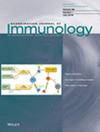复发/难治性 B 细胞急性淋巴细胞白血病患者 CAR-T 细胞疗法成功率的预测模型
IF 4.1
4区 医学
Q2 IMMUNOLOGY
引用次数: 0
摘要
嵌合抗原受体 T 细胞(CAR-T)疗法在治疗复发/难治性急性 B 细胞淋巴细胞白血病(R/R B-ALL)方面疗效显著。然而,有一部分患者并不能从CAR-T疗法中获益。我们的研究旨在确定预测指标,并建立一个评估CAR-T疗法可行性的模型。研究共招募了 55 名 R/R B-ALL 患者和 22 名健康供体。使用流式细胞术分析了外周血淋巴细胞亚群。确定了敏感性、特异性、准确性、阳性和阴性预测值以及曲线下接收者操作特征(ROC)面积(AUC),以评估指标的预测值。我们发现 B 淋巴细胞、调节性 T 细胞(Treg)和外周血最小残留白血病细胞(B-MRD)是预测 CAR-T 细胞制备成功与否的指标,其 AUC 分别为 0.936、0.857 和 0.914。此外,基于 CD3+ T 计数、CD4+ T/CD8+ T 比率、Treg 和髓外疾病(EMD)的模型被用来预测 CAR-T 疗法的反应,AUC 为 0.938。值得注意的是,基于 CD4+ T/CD8+ T 比率、B、Treg 和 EMD 的模型用于预测 CAR-T 疗法的成功率,AUC 为 0.966 [0.908-1.000],特异性(92.59%)和灵敏度(91.67%)均为 0.938。在验证组中,预测模型预测 CAR-T 疗法的成功率为特异性(90.91%)和灵敏度(100%)。我们确定了 CAR-T 细胞疗法成功与否的几个预测指标,并建立了一个模型,该模型对 CAR-T 疗法的成功与否具有很强的预测能力。这些结果表明,CAR-T 细胞疗法在指导临床知情决策方面具有巨大潜力。本文章由计算机程序翻译,如有差异,请以英文原文为准。

Predictive model for CAR-T cell therapy success in patients with relapsed/refractory B-cell acute lymphoblastic leukaemia
Chimeric antigen receptor T-cell (CAR-T) therapy has demonstrated remarkable efficacy in treating relapsed/refractory acute B-cell lymphoblastic leukaemia (R/R B-ALL). However, a subset of patients does not benefit from CAR-T therapy. Our study aims to identify predictive indicators and establish a model to evaluate the feasibility of CAR-T therapy. Fifty-five R/R B-ALL patients and 22 healthy donors were enrolled. Peripheral blood lymphocyte subsets were analysed using flow cytometry. Sensitivity, specificity, accuracy, positive and negative predictive values and receiver operating characteristic (ROC) areas under the curve (AUC) were determined to evaluate the predictive values of the indicators. We identified B lymphocyte, regulatory T cell (Treg) and peripheral blood minimal residual leukaemia cells (B-MRD) as indicators for predicting the success of CAR-T cell preparation with AUC 0.936, 0.857 and 0.914. Furthermore, a model based on CD3+ T count, CD4+ T/CD8+ T ratio, Treg and extramedullary diseases (EMD) was used to predict the response to CAR-T therapy with AUC of 0.938. Notably, a model based on CD4+ T/CD8+ T ratio, B, Treg and EMD were used in predicting the success of CAR-T therapy with AUC 0.966 [0.908–1.000], with specificity (92.59%) and sensitivity (91.67%). In the validated group, the predictive model predicted the success of CAR-T therapy with specificity (90.91%) and sensitivity (100%). We have identified several predictive indicators for CAR-T cell therapy success and a model has demonstrated robust predictive capacity for the success of CAR-T therapy. These results show great potential for guiding informed clinical decisions in the field of CAR-T cell therapy.
求助全文
通过发布文献求助,成功后即可免费获取论文全文。
去求助
来源期刊
CiteScore
7.70
自引率
5.40%
发文量
109
审稿时长
1 months
期刊介绍:
This peer-reviewed international journal publishes original articles and reviews on all aspects of basic, translational and clinical immunology. The journal aims to provide high quality service to authors, and high quality articles for readers.
The journal accepts for publication material from investigators all over the world, which makes a significant contribution to basic, translational and clinical immunology.

 求助内容:
求助内容: 应助结果提醒方式:
应助结果提醒方式:


